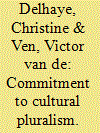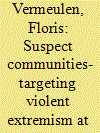|
|
|
Sort Order |
|
|
|
Items / Page
|
|
|
|
|
|
|
| Srl | Item |
| 1 |
ID:
127852


|
|
|
|
|
| Publication |
2014.
|
| Summary/Abstract |
Cultural policy has traditionally had close ties with the construction of the society as a nation state, which has been marked by its built-in tendency towards cultural homogenisation. Post-World War II, multicultural societies pose profound challenges to these traditional forms of cultural policy. Although, in the last decades, western democracies have been designing cultural diversity plans, this does not mean that governmental policies have successfully been translated in institutional practice. In the Netherlands, mainly established cultural institutions have failed to integrate diversity into their core business. Yet, there have been a few exceptions that continue to make attempts to adapt their programmes to address new populations. In this article, we use Parekh's view of a multiculturalism that reconciles unity and diversity, as a heuristic device that allows us to explore and examine the bottom-up diversity policies and practices of two Amsterdam-based cultural institutions: Paradiso and De Meervaart.
|
|
|
|
|
|
|
|
|
|
|
|
|
|
|
|
| 2 |
ID:
132294


|
|
|
|
|
| Publication |
2014.
|
| Summary/Abstract |
Throughout Europe, authorities have set up new policy measures and programs to curb homegrown violent extremists. This article describes local policy responses to violent Islamic extremism-and/or the mere threat of it-in the neighborhoods Oost in Amsterdam, Moabit and Soldiner Kiez in Berlin, and Tower Hamlets in London. Based on locally conducted fieldwork, the study compares and contrasts these neighborhoods' approaches and aims to make a first assessment of their effects. A major finding for all three cities is that authorities target the entire local Muslim community rather than a few select individuals. This can lead to the construction of suspect communities, an approach with possible paradoxical effects on targeting actual violent extremists. Suspect communities subsequently create stigmatization, exclusion, and possibly marginalization, which not only has negative consequences for involved groups, but may well produce a breeding ground for future violence. However, the author did not find that engagement with Islamic organizations or individuals was used to directly change the nature of local Muslim communities. Orthodox and non-violent extremist organizations and individuals in all three cities were potential partners for engagement, which probably lowers the chance of stigmatizing the suspect communities.
|
|
|
|
|
|
|
|
|
|
|
|
|
|
|
|
| 3 |
ID:
161093


|
|
|
|
|
| Summary/Abstract |
This article looks into the meaning of Tahrir Square before, during, and after the January 25 revolution. We employ Lefebvre's conceptual triad of space to understand how space is not merely a physical form, but also the product of relations between natural and social objects in this space. To understand how these relations changed dramatically after January 25, we will draw on Sewell's insight into how space is a constituent aspect of contentious politics. We discuss the way in which the political space of Tahrir Square went through distinct phases during and after the Egyptian revolution, from counter-space, to eventually a change in the conceived space of Tahrir Square, but not according to the principles of the newly created lived space during the 18 days.
|
|
|
|
|
|
|
|
|
|
|
|
|
|
|
|
|
|
|
|
|